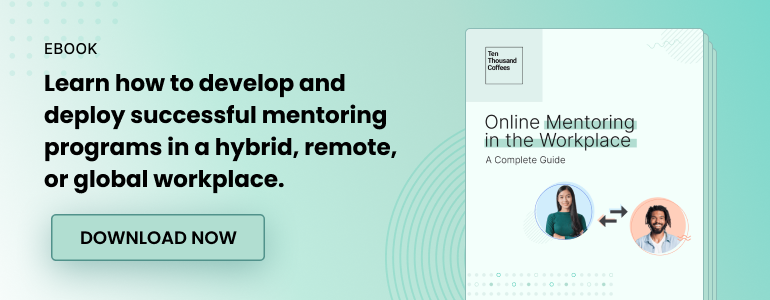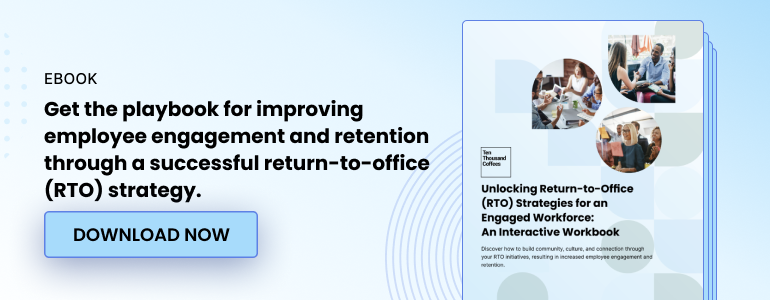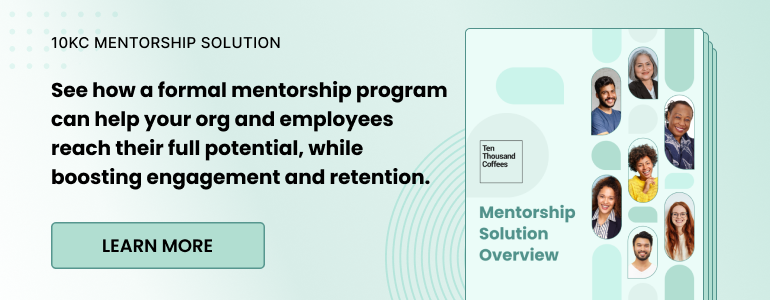The future of the workplace is here. And as it turns out, it’s hybrid. Thanks to technology—and an unprecedented pandemic—the way we work has been changed forever. But this new normal goes beyond just where we work. It impacts how organizations stay connected and keep employees engaged. The secret to tackling employee engagement in decentralized workplaces? Virtual mentoring.
According to Gallup, 5 in 10 employees have hybrid work arrangements and 3 in 10 work fully remote. Employees have generally welcomed this shift, but despite the positive sentiment, employee disengagement is at a 9-year high.
This disconnect ultimately comes down to faltering employee networks and a lack of connection in the virtual workplace.
So, let’s talk about how mentoring can effectively tackle employee engagement and other challenges in hybrid workplaces. Plus, we’ll share a few tips and tricks for building a high-impact virtual mentoring program in your hybrid organization.
The importance of mentoring for hybrid and remote workers
Mentorship goes a long way in building employee networks and driving career growth. And for hybrid and remote workers, it can have a substantial impact.
Mentorship improves employee engagement and retention
Remote employees are almost 2x less engaged than in-person employees.
Now, before you jump to conclusions and myths around lazy employees, disengagement can happen for many reasons. Employees are often missing the sense of purpose in their day-to-day that keeps them engaged, which can be related to a lack of connection to organizational goals or even their own personal goals.
Mentorship tackles these challenges head-on by creating learning and development opportunities, providing access to senior leaders, and highlighting the value of the work that your employees do. This raises employee motivation and job satisfaction, which translates into productive employees who want to stick around.
Mentorship fosters belonging in remote and hybrid teams
Collaboration is often first to go out the window when we’re stuck behind a screen—even if it’s only for part of the week.
Research by HBR shows that 40% of working people state they feel isolated at work, resulting in lower commitment to their organizations and lower engagement.
Mentorship puts the breaks on isolation by matching employees with peers and leaders. When you intentionally match employees with colleagues and peers or similar goals and interests, you can start to break down the silos that exist in the virtual workplace. Over time, these relationships contribute to an increased sense of community and belonging within teams.
Mentorship keeps employee development top of mind—even in the virtual world
It’s no secret that employee development impacts employee engagement and job satisfaction.
While almost all employees would agree development opportunities are important, it’s only natural that we forget about things that aren’t top-of-mind. In remote settings, it’s much easier for things like career development to fall off the radar—particularly for managers and leaders who can help pave the way for employee development opportunities.
Mentorship programs prevent career development from slipping through the cracks. By providing employees with wider networks and access to leaders who can help support their career growth, it puts employees back in the driver’s seat of their professional advancement. And when employees feel leaders support their advancement, they’re 1.2x more likely than others to feel very included.
Beyond just putting a plan in place for your employees, investing in employee learning and upskilling is also the key to building an internal talent pipeline that keeps your company growing far into the future.

Mentorship programs promote diversity, equity and inclusion (DEI)
When mentor-mentee relationships are left up to chance, it’s often employees from diverse and underrepresented backgrounds that get left behind.
Nearly 3 in 4 executives pick mentees that look like them. So, when all underrepresented groups make up less than 50% of board seats at Fortune 500 companies, it can be challenging for employees from diverse backgrounds to build relationships that can help advance their careers.
This gets exasperated in hybrid and remote settings, where organic connections by happenstance are few and far between. For example, if everyone is in the office, there’s a much higher chance that employees will build connections during their workday—whether it’s in the hallways, during lunch, or by the coffee maker. But these relationships are almost impossible in the virtual world where new connections only happen on video calls.
Having an intentionally diverse mentorship program makes certain that you’re including—and prioritizing—underrepresented groups. Not only does this promote inclusion but it creates a pipeline of future leaders that will contribute to a diverse leadership table in the long run.
Navigating the challenges of mentoring in a hybrid workplace
The benefits of mentorship in hybrid work environments can match—or even exceed—that of traditional in-person teams.
Of course, remote mentoring looks a bit different. The unique mix of in-person and virtual mentorship makes reaping all the benefits a bit more challenging, but certainly not impossible.
Some challenges teams face with mentoring in a hybrid environment include:
- A lack of organic connections: It’s difficult to recreate water cooler conversations if only a portion of the team is in the office at once. It’s likely why employee networks have shrunk by 19% since 2019. When organic relationships are a bit harder to come by, organizations need to play a bigger role in building employee connectivity.
- Less open communication: Remote and hybrid work environments often revolve around pre-set meetings. There’s less opportunity for ad hoc communication and feedback. This can make it challenging for mentors and mentees to provide and receive feedback in their day to day.
- A decrease in consistency: Successful mentorship relationships rely on consistent and regular interactions. This can be difficult to balance with all-too-busy employees constantly bouncing in and out of the office. Schedules and reminders play a much larger role in keeping mentorship programs on track in a hybrid or virtual environment.
- Effective relationships need a bit more structure: Mentorship relationships are built on trust. But it’s harder to nurture those relationships over a screen. Hybrid and virtual mentoring often benefit from more structured development programs or even conversation guides that help keep the relationship moving forward.
Despite the challenges, mentorship programs can still be high impact—as long as you keep your hybrid workers in mind.

How to build a mentoring program with hybrid workers in mind
Creating a virtual mentorship program that caters to remote and hybrid workers doesn’t have to be complicated. All you need are the right resources and tools.
Whether you’re searching for a solution to improve engagement in your hybrid team or looking to elevate your return-to-office, we’ve put together a few simple steps for how to start a mentoring program.
1. Define your program goals
Hybrid mentorship programs require structure. Without clear objectives in place, it’s easy for mentorship programs to stray from your organization’s needs.
For example, if your goal is to build a more connected team, you need to define what that looks like. Is that larger employee networks? More cross-department collaboration? A higher rate of employee belonging?
The SMART goal model is a tried-and-true method for creating relevant goals. You can use it as a benchmark to make sure you’re setting your mentorship program up for success.
Here’s how SMART goals work in the context of mentorship:
- Specific — Name what you want your mentorship program to achieve and why you want to achieve it.
- Measurable — You should be able to quantify some part of your mentorship goal and track your progress. For example, higher rates of employee satisfaction can be measured by an employee net promoter score (eNPS), among other metrics.
- Achievable — Mentorship program goals should be ambitious but realistic. For example, you’re not going to be able to reasonably commit to having a 100% employee retention rate.
- Relevant — Your goals should line up with your company’s goals. Improving employee engagement, for example, could align with your company’s overall goals of winning a “Best Place to Work” award or improving your average review score on sites like Glassdoor.
- Time-bound — Deadlines will help you create a realistic timeline to achieve your goals. Otherwise, it’s easy for the organization and your employees to put mentorship on the back burner.
2. Make flexibility the basis of the program
Hybrid and remote working arrangements are built on the foundation of flexibility. So your mentorship program should be too.
Generally, virtual mentorship is a good solution for hybrid workplaces, since employees can engage digitally whether they’re at home or in the office. This means you should have solutions to make mentorship matches and facilitate meetings virtually.
But that doesn’t mean employee mentorship has to exclusively live in the virtual world. If mentors and mentees have opportunities to work together in person, your program should make it possible for this to happen.

3. Use employee goals and interests as your primary matching criteria
This is particularly important for large enterprises, where there are hundreds—if not thousands—of potential mentorship matches.
The benefit of a virtual mentoring program is that employees can get access to mentors across the entire organization. It removes the limitations around geographic locations or the need to make matches within immediate teams.
Expanding match options for employees is undoubtedly beneficial, but the true success of a mentorship program lies in pairing mentors and mentees with compatible goals. This ensures that each participant not only derives value but also guarantees the formation of robust mentor-mentee connections. In essence, it ensures that the mentorship program creates the most effective and mutually beneficial matches possible.
Of course, with digital-first or remote mentorship, you still need to consider work hours and time zones in your matches. The last thing you want is to have mentors and mentees struggling to connect due to work-hour constraints.
4. Expand employee networks beyond a single mentor
Over time, a robust network of mentors and peers helps employees build their careers.
A mentor’s expertise has the power to change the trajectory of a mentee’s path to success. But no one person has all the answers, which is why mentorship and employee connectivity should be community-based and go beyond a single mentor-mentee relationship.
By expanding employee networks you can help them:
- Grow and develop their skill sets.
- Experience diverse ideas and perspectives.
- Build cross-functional relationships to improve collaboration.
- Provide opportunities to help them discover and shape their own career path.
- Improve team-wide communication skills. .
5. Gather and act on feedback throughout the program
Remember those goals you set earlier? Here’s where you make sure you actually reach them.
A pre-program survey paired with a post-completion survey can help you stay on top of your progress. Don’t just wait until your program wraps up to survey participants. Feedback gathered while your program is still running can help you correct issues as they occur.
The best mentorship platforms give HR teams real-time data in a centralized spot about how their program is going and what type of connections employees are making. Automating feedback takes out the hassle of manual follow-ups and helps everyone get the most out of mentorship by measuring progress over time.
6. Offer frequent nudges and check-ins
Employees are busy—which unfortunately means that mentorship programs can often fall between the cracks. This is particularly true in hybrid environments where employees don’t have the benefit of running into their mentor in the halls.
Instead of leaving it up to mentors and mentees to come up with their own meeting cadence, hybrid mentorship often benefits from structured programs. These curriculums can support development and relationship building. They also keep mentors and mentees on track.
Want to take it a step further? Integrate mentorship programs with your tech stack, enhancing connections and simplifying the participant experience through automated invitations and mentorship reminders.
7. Invest in hybrid mentoring software
Hybrid mentoring goes beyond putting two people in a room together. Investing in the right mentoring software is key to building an effective remote mentoring program that your employees truly want to participate in.
Here are some things to look for when choosing a mentoring software for your hybrid mentorship program:
- Scalable and meaningful mentorship matches: Save yourself the spreadsheet headache. Instead of manual matching, choose a mentoring platform that allows you to make unbiased mentorship matches at scale. 10KC’s Smart Match algorithm pairs employees based on shared goals, interests, and even working locations in just a few clicks.
- Technology integrations: Remote and hybrid teams can often be inundated with different platforms and software. Make mentorship simple by investing in mentorship software that seamlessly integrates into your existing tools and systems. 10KC delivers your mentorship program via email, so everything employees need—from introductions to calendar invites—is right in their inbox.
- Flexible and customizable programming: From 1-1 mentorship to group Office Hours, 10KC makes it easy for organizations to implement mentorship and development programs in whatever way works best for their teams. Custom-tailored curriculums can also take your mentorship program to the next level by guiding conversations. Need a simpler solution? Our pre-build library of development programs can have you up and running quickly.
- Data-driven decision making: Real-time results help drive real impact. Choose a mentorship solution that helps you keep a pulse on your program. 10KC makes it easy for you to collect feedback and send surveys. Plus, access all insights right away in your own Data Dashboard, so you can feel confident that employees are getting value and you’re moving one step closer to your talent goals.
Start a remote mentoring program today with 10KC
10KC helps organizations deploy high-impact mentorship programs that employees love.
.png)









.png)